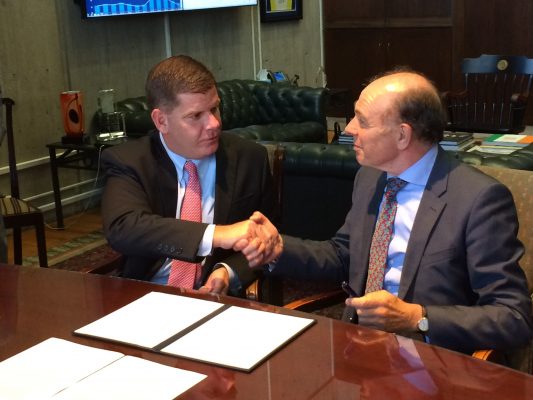Here Comes the Flood, and Here Come the Dutch
The sea is rising. The threat from hurricanes is growing. That’s bad news for Boston, since so much of it is built on land that once wasn’t land. The Back Bay used to be a bay. Castle Island used to be an island.
So, to prepare for a future Hurricane Sandy and the creeping rise of the Atlantic Ocean, Boston is turning to the Dutch—the world’s experts at living below sea level. On Wednesday, Mayor Marty Walsh signed an agreement with Rob de Vos, consul general of the Netherlands, to work together on plans for managing floods.
The Netherlands’ name means “low country,” and more than a quarter of the nation lies below sea level. Ever since a catastrophic flood in 1953, the Dutch have lived safely behind a vast system of barriers and dikes. They’ve created an entire 12th province out of land reclaimed from the sea.
“We know we have to be prepared for more surges,” de Vos said at City Hall on Wednesday. “The first [approach], of course, is to block it. Secondly, if we can’t do that, we have to take care to at least control it. Then, to store water. And finally to do away with it in the most practical, ecologically sound way.”
Late this summer, Dutch flood specialists are expected to visit, meet with greater Boston leaders and develop a partnership. By fall, a Boston delegation is expected to travel to the Netherlands to study its climate preparedness work. The goal is for the Dutch to show Boston how to plan for storm surges and rising tides, across the region and down to a single office building. The partnership will add to work already done by the Boston Green Ribbon Commission, a climate-change action group.
“We’re just now starting to face this problem,” says Austin Blackmon, the city’s chief of environment, energy and open space. “We’re looking forward to learning from the Dutch model.”
Boston isn’t necessarily about to throw up a bunch of Dutch-style dikes. It’s too early to say where the partnership will take Boston, says Blackmon. If the city needs a seawall someday, the partnership could teach the region how to design it and set up its governance. Or, Boston could learn about flood recovery: “How make sure your buildings are able to respond quickly,” Blackmon says, “that you’re able to get residents in a position where they can thrive again.”



